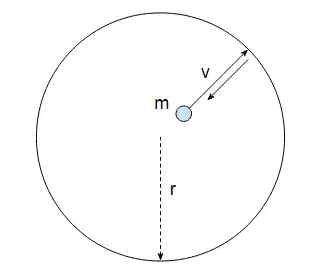There are probably several ways to approach this, but I think a nice simple way is to consider the microscopic mechanism that produces pressure.
Imagine a spherical container of some radius $r$ with just one gas particle in it. Our gas particle has a mass $m$ and a velocity $v$.

When the gas particle hits the walls of the vessel and bounces back it exerts a force on the walls of the vessel. This is just the same as if I throw a heavy object at you so the object exerts a force on you when it hits you. To calculate this force you need to know that force is the same as rate of change of momentum.
At each collision the particle velocity changes from $v$ to $-v$, so the momentum changes from $mv$ to $-mv$, so the momentum change is $\Delta p = 2mv$.
The time the particle takes to cross the sphere is $\tau = 2r/v$, so the number of collisions per second is $f = 1/\tau = v/2r$.
And the rate iof change of momentum, i.e. the force' is just the momentum change per collision $\Delta p$ times the number of collisions per second $f$:
$$ F = \Delta p f = 2mv \frac{v}{2r} = \frac{mv^2}{r} $$
And finally, pressure is force per unit area and the area of the sphere is $4\pi r^2$, so we end up with the equation for the pressure:
$$ P = \frac{F}{A} = \frac{mv^2}{4\pi r^3} \tag{1} $$
Now you asked how come the pressure is inversely proportional to the volume? Well the volume of a sphere is:
$$ V = \tfrac{4}{3}\pi r^3 $$
And we can substitute this into our equation (1) to get:
$$ P = \frac{F}{A} = \frac{mv^2}{3V} \tag{2} $$
So we find that $P \propto 1/V$.
If you're interested we can do better than this because the equipartition of energy tells that the kinetic energy of the particle at a temperature $T$ will be about $\tfrac{3}{2}kT$. So we get:
$$ \tfrac{1}{2}mv^2 = \tfrac{3}{2}kT $$
and we can use this substitute for $mv^2$ in equation (2) to get:
$$ P = \frac{kT}{V} \tag{3} $$
So we've also got Guy-Lussac's law $P \propto T$.
And there's one last step. All this was for just one particle. If we have one mole of gas then that's $N_a$ particles, where $N_a$ is Avagadro's number. Each particle contributes the same momentum change, so the total force from all those particles is just:
$$ P = \frac{N_a kT}{V} $$
And the product $N_a k$ is just the ideal gas constant $R$ so our final equation is:
$$ P = \frac{RT}{V} $$
which you should immediately recognise as the ideal gas law.
Now I've played a pretty fast and loose with this derivation and there all sorts of objections. For example the gas molecules have a range of velocities and they don't all hit the walls straight on. However the spirit of the derivation is fine even if the detail isn't, and hopefully this helps explain exactly why the ideal gas law has the form that it does.
